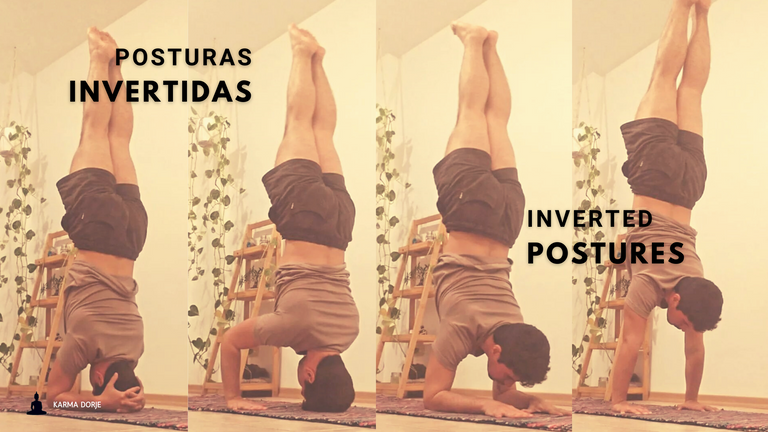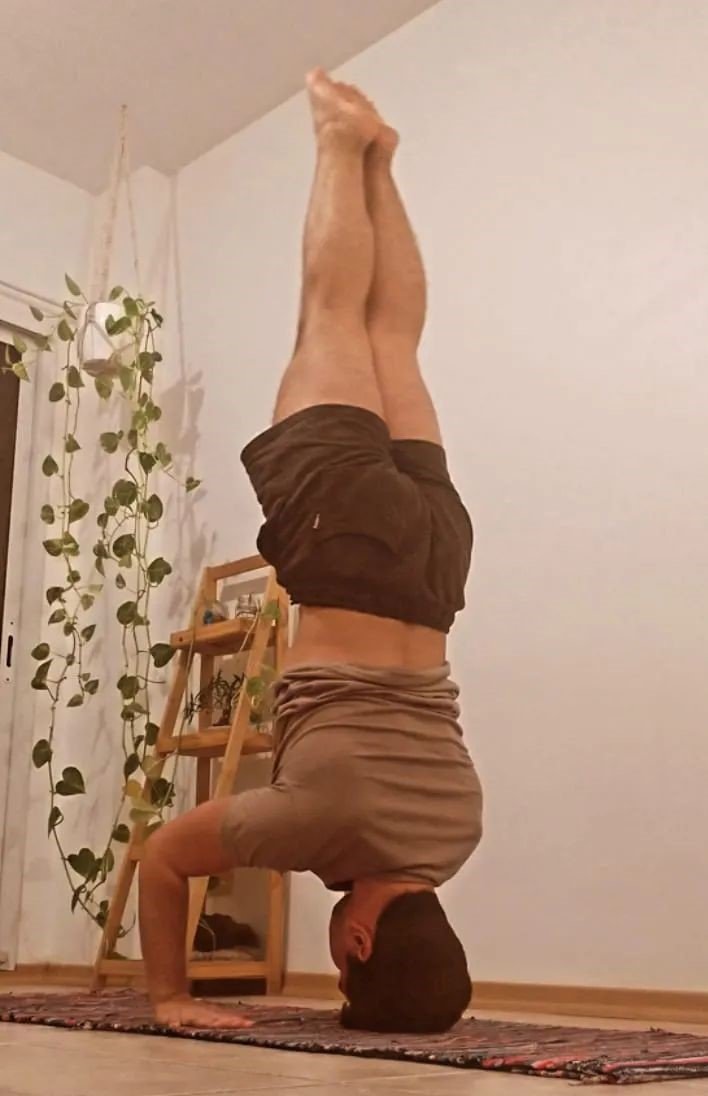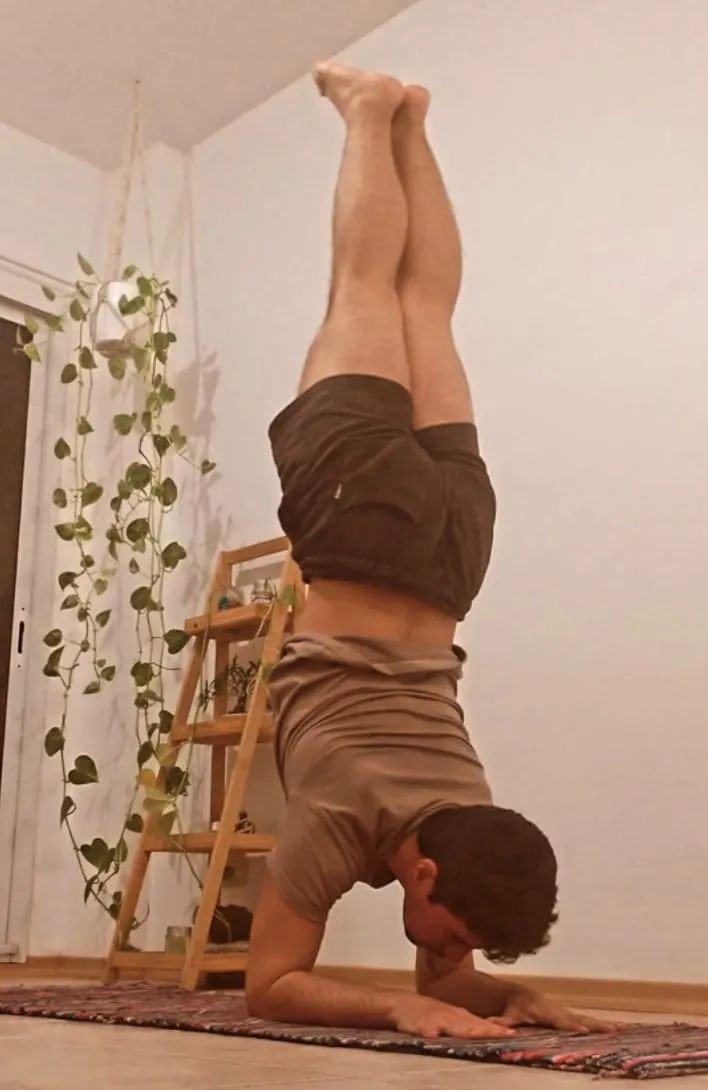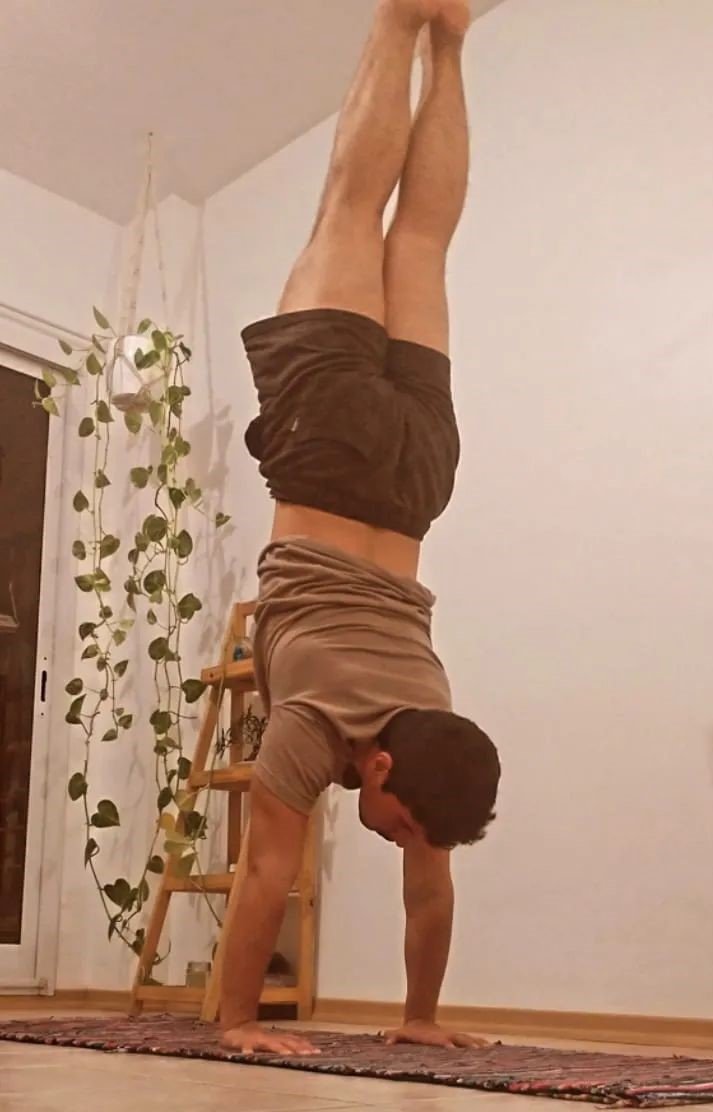
ESPAÑOL
Asanas Invertidas
Las posturas invertidas son aquellas, en una práctica de Yoga donde el corazón se encuentra en una posición por debajo de la cabeza. Son muchas las posturas invertidas que pueden llegar a realizarse en una sesión de Asanas de Yoga. Siendo, generalmente las posturas de las imagenes las más conocidas y las mas interesantes para los practicantes.
Tienen muchos beneficios a nivel físico, pues fortalecen mucho todo el cuerpo, tienen una capacidad de restauración de la energía si se realizan por largos periodos respiratorios, y los textos antiguos explican que mantienen el cuerpo con gran vitalidad y longevo. Igualmente tienen ciertas contraindicaciones, por ejemplo, para personas con ciertas condiciones como glaucoma (tensión ocular alta), embarazadas principiantes, entre otros.
Pero más allá de sus beneficios físicos, hoy quisiera hablar sobre el aspecto psicológico y mental.

Asana: Sirsasana
No hay a nadie, que en los primeros pasos de su práctica del Yoga - los primeros meses -, no experimente movilización emocional al momento de hacer las posturas invertidas.
¡Que miedo que dan!
Son como un gatillo que desenvuelve distintos procesos mentales, muy interesantes, que nos permiten conocernos profundamente.
Está aquellas personas que tienen un miedo intenso a caerse -lo desconocido les aterra -.
Están quiénes no les gusta arriesgarse a entrar en esa situación pues la recompensa o posible desenlace (caerse) no les motiva lo suficiente o les resulta poco interesante.
Otras en cambio lo ven como un reto demasiado llamativo como para dejar de intentarlo. Y además se impacientan si no les sale a la primera vez.
Y así, muchos mas posibilidades que pueden verse en una misma clase de Yoga.

Asana: Mukta Hasta Sirsasana
Desde mi visión como enseñante de Yoga, resulta muy interesante ver los distintos procesos y abordajes que hay respecto a estas posturas (lo mismo ocurre con otros tipos de posturas en una clase), pues aclara rápidamente la personalidad de mucha gente.
Es como si atribuyésemos - inconscientemente- a cada postura una situación de vida especifica y proyectamos en ellas nuestras emociones ante dicha situación (una construcción mental claramente), y nos genera satisfacción, deseo, impaciencia o sobretodo miedo resolverla en ese momento.
Como si en el instante en que armas el asana (postura en sanscrito), tu mente se transporta a una situación de vida que te evoca miedo, deseo, pereza, excitación o alguna otra emoción... Y si tu guía es lo suficientemente perspicaz podrá acompañarte correctamente para que puedas afrontarla de la manera más sabia, es decir, plenamente presente y atenta a lo que estás viviendo -desde la respiración consciente-.
Entre las opciones que surgen en ese momento, producto de esas emociones y sentimientos que evoca la postura, escuchamos lo típico:
¿Puedo hacerlo en la pared? (Miedo)
¡Pero no te vayas a alejar! (Desconfianza)
¿Puedo intentarlo de nuevo? - como por enecima vez, jaja - (Impaciencia)
¡¿Estás ahí?! (Sensación de soledad y desconfianza)
Comentarios típicos que surgen cuando nos toca por primera vez hacer estas posturas y sentimos ¡pavor!... Aunque realmente ni siquiera sabemos a qué se deba ese miedo en la mayoría de los casos, porque no sabemos ni cómo es esa caída, ni cuán dolorosa, ni cuán grave o inofensiva sea.
Sólo sabemos que tenemos miedo, racional o no, lo tenemos...
Y eso nos paraliza...
Pero si estás ahí, haciendo tu práctica de Yoga, no es solo por lo físico (aunque quizás aun no lo has descubierto).
Es también - y sobretodo - para poder ver a la cara tus miedos, la prepotencias, la impaciencia, las limitaciones y expectativas, y poder enfrentarlas... así sea con pasos cortos, con pasos de bebe.

Asana: Pinchamayurasana
No claudicar es importante. Aunque la situación sea difícil, respira. Aunque la situación sea sencilla, respira.
De respiro en respiro, se va abriendo el camino y la mente se libera de sus condicionamientos.
Como dice Goenka (un reconocido maestro de meditación):
Con paciencia y persistencia los objetivos son cumplidos.
Finalmente, habrás conquistado - espero que amorosamente - esos miedos o habrás actuando aún con el miedo presente - valientemente -. E irás en busca de una nueva situación para conquistar. Sino, el aprendizaje aun estará cultivándose en tu interior y podrás desarrollar tu paciencia.

ENGLISH
Inverted Asanas
Inverted postures are those in a Yoga practice where the heart is in a position below the head. There are many inverted postures that can be performed in a Yoga Asana session. Generally, the postures of the images are the best known and the most interesting for practitioners.
They have many benefits at a physical level, as they strengthen the whole body, have a capacity to restore energy if performed for long periods of breathing, and ancient texts explain that they keep the body with great vitality and longevity. They also have certain contraindications, for example, for people with certain conditions such as glaucoma (high eye pressure), pregnant beginners, among others.
But beyond its physical benefits, today I would like to talk about the psychological and mental aspect.

Asana: Adho Mukha Vrksasana
There is no one, who in the first steps of his practice of Yoga - the first months -, does not experience emotional mobilization at the time of doing the inverted postures.
How scary they are!
They are like a trigger that unwraps different mental processes, very interesting, that allow us to know ourselves deeply.
There are those people who have an intense fear of falling - the unknown terrifies them.
There are those who do not like to risk getting into that situation because the reward or possible outcome (falling) does not motivate them enough or they find it uninteresting.
Others see it as too much of a challenge to stop trying. And they get impatient if they don't succeed the first time.
And so, many more possibilities that can be seen in the same Yoga class.
From my point of view as a Yoga teacher, it is very interesting to see the different processes and approaches to these postures (the same happens with other types of postures in a class), because it quickly clarifies the personality of many people.
It is as if we attribute - unconsciously - to each posture a specific life situation and we project in them our emotions before that situation (clearly a mental construction), and it generates satisfaction, desire, impatience or above all fear to solve it at that moment.
As if in the instant that you do the asana (posture in Sanskrit), your mind is transported to a life situation that evokes fear, desire, laziness, excitement or some other emotion... And if your guide is insightful enough, he or she will be able to accompany you correctly so that you can face it in the wisest way, that is, fully present and attentive to what you are experiencing -from conscious breathing-.
Among the options that arise at that moment, product of those emotions and feelings that the posture evokes, we hear the typical:
Can I do it on the wall? (Fear)
But don't go away! (Mistrust)
Can I try it again? - like for the eleventh time, haha - (Impatience)
Are you there?! (Feeling of loneliness and distrust)
Typical comments that arise when it is our first time to do these postures and we feel "awe".... Although we really do not even know what this fear is due to in most cases, because we do not even know how that fall is, nor how painful, nor how serious or harmless it is.
We only know that we are afraid, rational or not, we are afraid....
And that paralyzes us...
But if you're there, doing your Yoga practice, it's not just about the physical (though maybe you haven't figured that out yet).
It is also - and above all - to be able to look your fears, arrogance, impatience, limitations and expectations in the face, and to be able to face them... even with small steps, with baby steps.
Not giving up is important. Even if the situation is difficult, breathe. Even if the situation is easy, breathe.
From breath to breath, the path opens up and the mind frees itself from its conditioning.
As Goenka (a renowned meditation teacher) says:
With patience and persistence goals are accomplished.
Finally, you will have conquered - I hope lovingly - those fears or you will have acted even with the fear present - valiantly -. And you will go in search of a new situation to conquer. Otherwise, the learning will still be cultivating within you and you will be able to develop your patience.

Soy Julio Cesar Arvelo, practicante y profesor de Ashtanga Yoga y Meditación.
- Si te gustó este post y quieres seguir leyéndome, bienvenido a seguirme.
-Todas las imagenes han sido creada por mi através de Canva.com
I am Julio Cesar Arvelo, practitioner and teacher of Ashtanga Yoga and Meditation.
- If you liked this post and want to keep reading me, welcome to follow me.
- All images have been created by me through Canva.com.
Mi redes sociales:

Genial tu post totalmente cierto, una postura que me parece muy bella es Pinchamayurasana pero aún me cuesta armarla, pero paso a paso!
Si! Con paciencia y persistencia se logra. Previo y posterior a la postura, haz un estiramiento de hombros y apertura de pecho. Que te ayude a sentirte mejor en el Asana